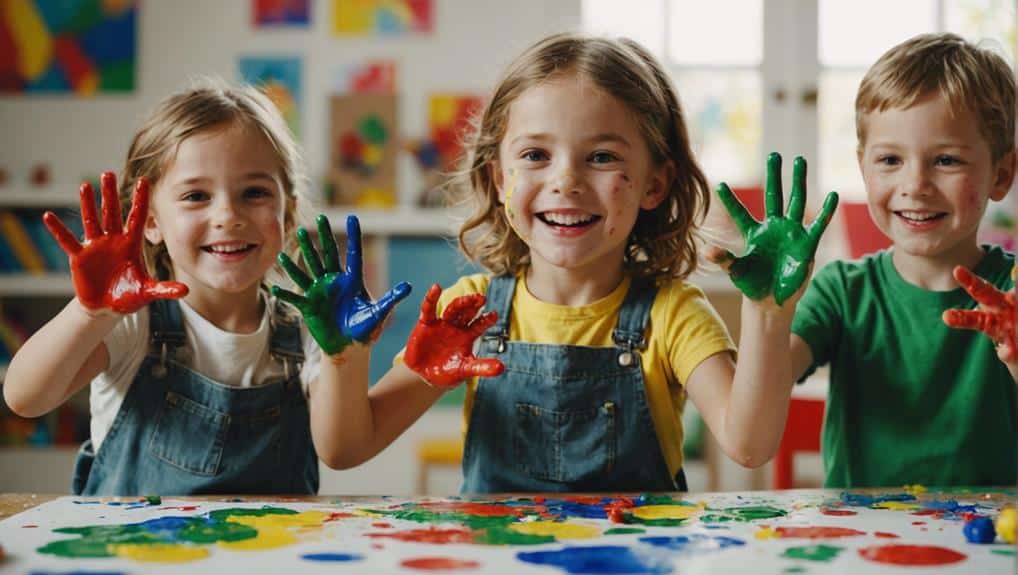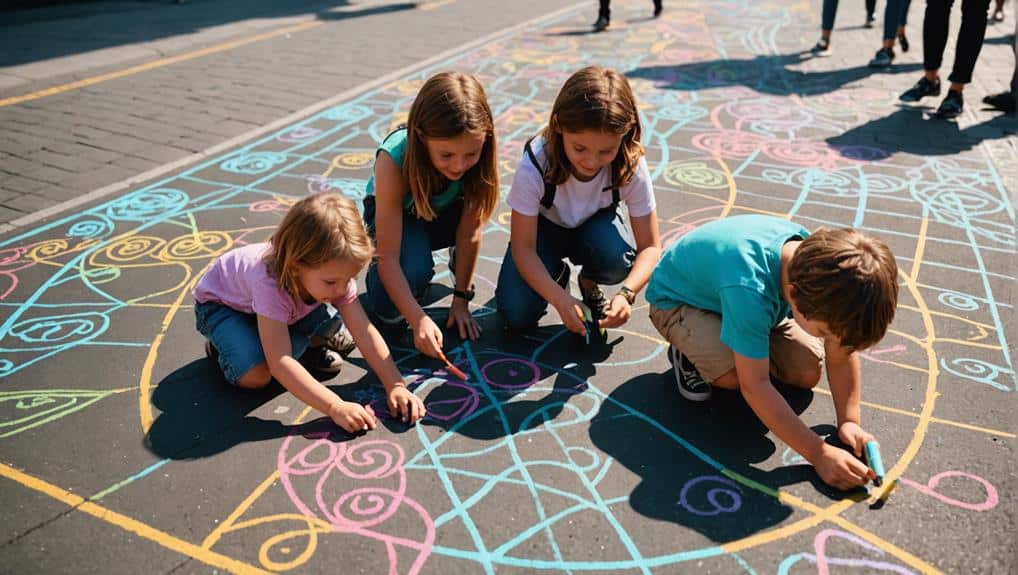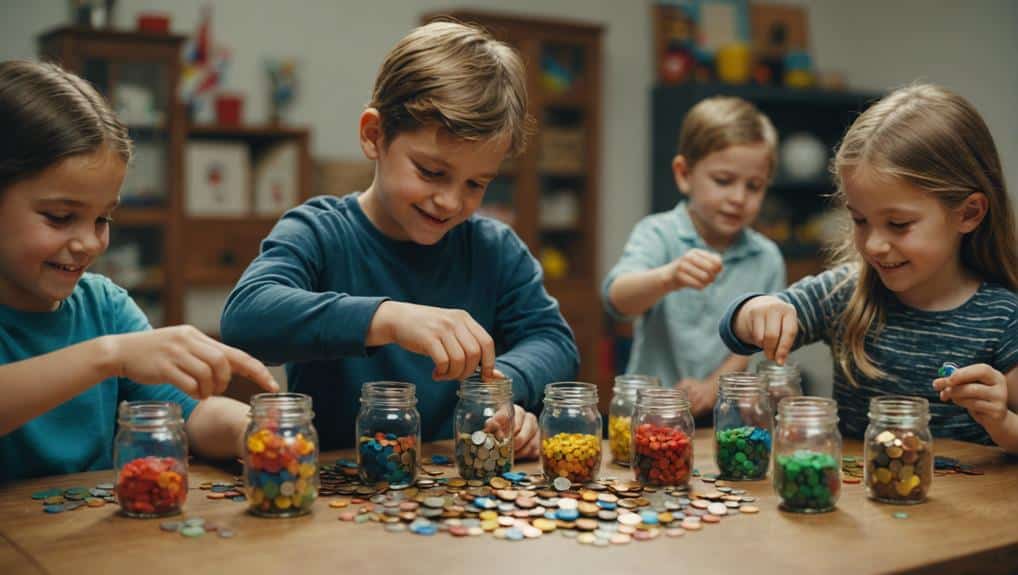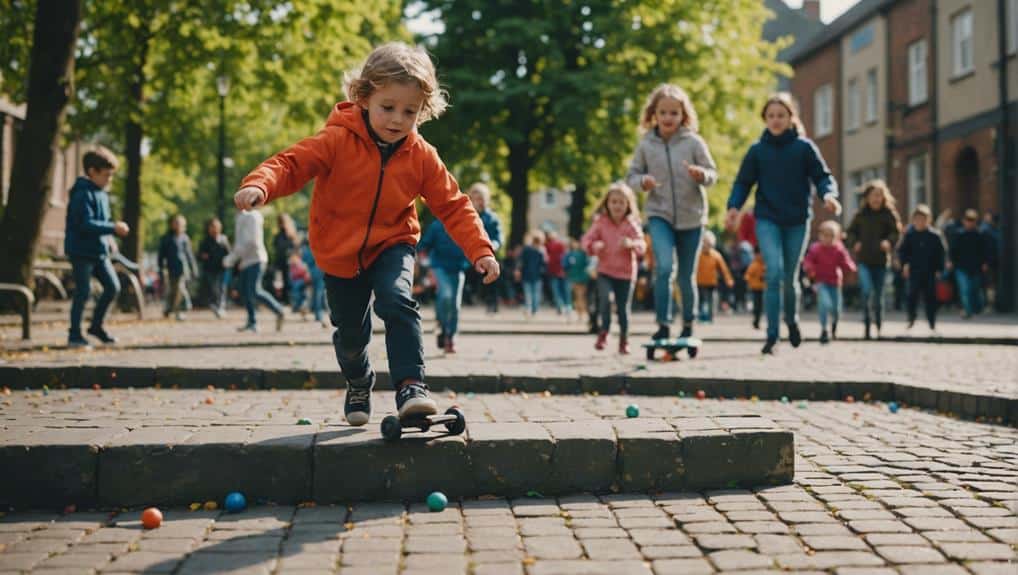Enhancing your child’s motor skills can be both enjoyable and educational with these ten fun activities. Playdough creations help develop motor skills by improving fine motor and hand-eye coordination. Obstacle courses and dance parties build gross motor skills and agility.
Finger painting encourages creativity and sensory experiences. Bead threading improves precision in movements. Sidewalk chalk engages artistic expression and gross motor skills. Bubble popping enhances hand-eye coordination. Coin sorting aids cognitive development. Clothespin play strengthens pinching and grasping abilities.
Each activity is designed to entertain and develop motor skills in various ways. These activities make learning fun and effective. These engaging activities can support your child’s physical, cognitive, and creative growth. Discover more ways to make learning fun and develop motor skills simultaneously.
Key Takeaways
- Obstacle courses enhance gross motor skills, agility, and physical fitness.
- Playdough creations develop fine motor skills, hand-eye coordination, and creativity.
- Soccer improves gross motor skills, physical fitness, and teamwork.
- Bead threading enhances fine motor skills and hand-eye coordination.
- Coin sorting fosters cognitive development and introduces fundamental math concepts.
Playdough Creations
Engaging in playdough creations offers children a multifaceted developmental experience by strengthening hand and wrist muscles, enhancing hand-eye coordination, and promoting creativity. Rolling, squeezing, and molding playdough are activities that significantly contribute to the development of hand strength and fine motor skills. As children manipulate the play dough, they hone their finger dexterity and build essential hand muscles, vital for tasks such as writing and buttoning clothes.
Moreover, playdough’s tactile nature makes it an excellent tool for sensory processing. Children explore different textures and consistencies, which can help them become more comfortable with various sensory inputs. This sensory engagement supports their ability to process and respond to sensory information effectively.
Playdough activities can be educational in addition to physical and sensory development. Creating shapes, letters, and numbers with playdough promotes creativity and reinforces early learning concepts. This hands-on approach to education makes learning enjoyable and memorable.
For those dedicated to serving children’s developmental needs, incorporating playdough into playtime can be a simple yet significant way to support overall growth. It provides a balanced blend of physical, sensory, and cognitive development that is both engaging and beneficial.
Obstacle Courses
Following the imaginative and fine motor skill development offered by playdough creations, obstacle courses provide an excellent way to enhance children’s gross motor skills and physical fitness through dynamic and engaging activities. Obstacle courses are physical challenges meticulously designed to test and improve coordination, balance, agility, and strength in children.
These courses typically involve a series of stations or tasks that require movements such as crawling, jumping, balancing, and climbing. By engaging large muscle groups, obstacle courses promote gross motor skill development. They can be easily set up indoors or outdoors using household items, playground equipment, or even small objects to create various challenges.
The benefits of obstacle courses extend beyond physical fitness. Children develop spatial awareness and motor planning, essential to overall physical abilities. Tasks within the course often demand precise coordination, further refining their motor skills. For example, balancing on a beam or maneuvering through a series of cones enhances their spatial perceptions and movement strategies.
Incorporating obstacle courses into children’s routines can foster significant developmental progress while providing fun, stimulating activities. By creating these dynamic challenges, caregivers and educators can effectively support children’s physical and cognitive growth.
Finger Painting

Finger painting is a sensory-rich activity that offers children a creative and developmental experience through color and texture exploration. This hands-on practice is instrumental in promoting fine motor skills by encouraging small finger muscles to manipulate paint and create art. Children engage in finger painting and develop hand-eye coordination and finger dexterity, which are all to their overall motor skill development.
The benefits of finger painting extend beyond mere artistic expression. Children strengthen hand muscles and improve grip strength through the tactile experience of spreading paint with their fingers. This activity also enhances grasp patterns and finger isolation, essential for tasks requiring precise fine motor control, such as writing and buttoning clothes.
Furthermore, finger painting provides a platform for children to express their creativity and uniqueness. Mixing colors and feeling different textures can be stimulating and soothing, contributing to a well-rounded sensory experience. Educators and caregivers can facilitate this activity mess-free by using washable paints and protective coverings, ensuring children can explore and learn without concern. By incorporating finger painting into their routines, caregivers can support children in achieving essential developmental milestones through engaging, hands-on activities.
Bead Threading
Bead threading is an excellent activity for children to develop fine motor skills. Children enhance hand-eye coordination, pincer grasp, and bilateral coordination by stringing beads onto a lace or string. This engaging task is enjoyable and profoundly beneficial for a child’s hand and finger strength, contributing immensely to their fine and gross motor development.
To make bead threading an enriching experience, consider the following points:
- Diverse Bead Choices: Use various types of beads, such as wooden, plastic, or large pony beads, to keep the activity exciting and adaptable to different skill levels.
- Creativity and Focus: Encourage children to create patterns or designs with the beads, which promotes creativity and sustained attention.
- Incremental Difficulty: Start with larger beads and gradually introduce smaller ones to challenge and improve the child’s skill and precision.
Children can refine their fine motor abilities through bead threading while enjoying a creative and focused activity. This simple yet effective exercise is a beautiful way to support a child’s overall motor development and allows caregivers to engage meaningfully with their young learners.
Improve Motor Skills With a Dance Party

Dance parties are dynamic and enjoyable activities that foster children’s development of gross motor skills through energetic movement and coordination. Engaging in dance promotes the enhancement of rhythm, balance, and spatial awareness, essential components of motor skills activities. Children can explore various dance styles and movements by moving to music, boosting creativity and supporting physical expression.
Incorporating dance parties as a regular activity offers a lively platform for children to interact socially, improving teamwork and cooperation. This group activity encourages children to follow rhythms and patterns, enhancing their ability to synchronize movements with others and fostering a sense of community and shared enjoyment.
Furthermore, dance parties are beneficial for cardiovascular health and overall physical fitness. The continuous movement involved in dancing helps children build endurance and strength, contributing positively to their overall well-being. Parents and educators can facilitate these sessions by providing a variety of music genres and encouraging imaginative dance moves, ensuring that the activity remains engaging and enjoyable.
Ball Games
As dance parties invigorate children’s physical and social skills, ball games offer a dynamic avenue for developing coordination, balance, and teamwork. Playing ball games is an excellent way to enhance gross motor skills, allowing children to improve their agility and muscle strength. These activities are invaluable for cultivating hand-eye coordination and spatial awareness in kids of all ages.
Participating in ball games also fosters essential social skills. Interaction through teamwork and communication is a natural part of these activities, encouraging children to collaborate and cooperate effectively. Moreover, outdoor ball games promote physical exercise, improving overall health and well-being.
Here are three engaging ball games that can help develop these critical motor skills:
- Catch and Throw: A simple yet effective game to boost hand-eye coordination, catching and throwing a ball helps refine motor planning and muscle control.
- Soccer: Kicking a ball around builds gross motor skills, enhances balance, and enhances agility. It also provides a fun way for children to engage in teamwork.
- Dodgeball: This game requires quick reflexes and spatial awareness, making it an excellent activity for improving overall coordination and physical fitness.
Sidewalk Chalk

Sidewalk chalk provides a versatile and engaging way for children to explore their creativity while enhancing fine motor skills through drawing shapes and patterns. Furthermore, classic games such as hopscotch and jump games can be easily set up, promoting physical movement and coordination. Children can also practice essential literacy and numeracy skills by tracing the alphabet and numbers, making learning fun and interactive.
Draw Shapes and Patterns
Drawing shapes and patterns with sidewalk chalk provides an engaging and developmental outdoor activity that promotes fine motor skills, spatial awareness, and creativity in children. Pediatric occupational therapists often recommend such motor activities to help children enhance their hand-eye coordination and fine motor skills. Children can improve their precision and control by tracing and imitating shapes, which is crucial for other hand-related tasks such as writing.
Here are three key benefits of sidewalk chalk activities:
- Fine Motor Development: Drawing intricate patterns like zigzags, loops, and spirals helps children develop the small muscles in their hands and fingers, vital for tasks requiring skill and precision.
- Spatial Awareness: Creating and following patterns with chalk fosters spatial understanding and visual motor coordination. This helps children understand spatial relationships and improves their ability to navigate their environment.
- Cognitive Skills: These activities support cognitive development by enhancing problem-solving and sequencing abilities. Children learn to plan and execute complex patterns, which sharpens their thinking and planning skills.
Incorporating sidewalk chalk activities into a child’s routine supports physical development and nurtures creativity and cognitive growth, making it a fundamental and enjoyable approach to learning and development.
Hopscotch and Jump Games
Engaging in hopscotch and jump games using sidewalk chalk offers children an enjoyable way to develop essential gross motor skills such as balance, coordination, and agility. These activities require children to regulate motor control, enhancing their ability to coordinate movements effectively. The coordination required in hopscotch, for instance, involves jumping on one foot, then both feet, and following a specific pattern, which helps improve balance and spatial awareness.
Playing hopscotch and other jump games promotes physical activity, contributing to cardiovascular health. Repeated jumping strengthens leg muscles, improves bone density, and enhances physical fitness. Additionally, these games encourage proprioception and body control as children learn to navigate spaces and adjust their movements accordingly.
Furthermore, hopscotch can foster social interaction and turn-taking among children, teaching them valuable social skills. The collaborative nature of these activities can create a sense of community and shared enjoyment. Children can personalize their play area by integrating sidewalk chalk into these games, making the activity more engaging and stimulating.
Incorporating such fun and developmentally beneficial activities into a child’s routine can significantly support their gross motor skills and overall well-being.
Alphabet and Number Tracing
Utilizing sidewalk chalk for alphabet and number tracing offers children a dynamic and enjoyable method to practice letter and number formation while enhancing fine motor skills and hand-eye coordination. This engaging outdoor activity promotes the development of essential hand muscles and helps children become more familiar with the alphabet and numerical sequences in a playful manner.
The benefits of sidewalk chalk tracing extend beyond simple letter and number practice. Children can creatively engage in physical movement while learning, making it a pivotal developmental exercise. Here are three ways to maximize the effectiveness of this activity:
- Name Tracing: Have children trace their names to improve familiarity with the letters and enhance their fine motor skills.
- Simple Words and Math Equations: Encourage tracing simple words or basic math equations to help develop literacy and numeracy skills.
- Creative Patterns: Allow children to create patterns or designs around the letters and numbers, fostering creativity and enhancing hand-eye coordination.
Involving children in alphabet and number tracing with sidewalk chalk can significantly contribute to their developmental journey. It combines learning with physical activity and creativity while fostering fine motor skills and hand-eye coordination.
Bubble Popping
Bubble popping is an engaging activity that significantly enhances children’s hand-eye coordination and finger dexterity. Kids improve their visual tracking skills by tracking and catching bubbles while enjoying a fun sensory experience. This activity, suitable for indoor and outdoor play, also provides an interactive way to develop fine motor skills through active movement.
Hand-Eye Coordination Boost
Bubble popping improves hand-eye coordination in children and is an enjoyable activity that sharpens visual tracking and fine motor skills. This simple yet effective activity is frequently used in occupational therapy to enhance these essential developmental skills. Popping bubbles demands precision and focus, which significantly boosts hand-eye coordination. Moreover, the fine motor skills required to precisely target and pop each bubble are integral to a child’s overall motor development.
Engaging in bubble-popping activities provides several developmental benefits:
- Visual Tracking Skills: Children enhance their ability to follow moving objects with their eyes, which is vital for reading and other academic tasks.
- Fine Motor Skills: The precise finger movements required to pop bubbles help strengthen small muscles in the hands, which is beneficial for writing and other detailed tasks.
- Depth Perception and Spatial Awareness: Aiming to pop bubbles helps children understand distances and spatial relationships, essential for physical activities and daily tasks.
For parents and caregivers, incorporating bubble popping into play routines can be a therapeutic and engaging way to support children’s development. This activity entertains and fosters essential skills contributing to a child’s growth and independence.
Sensory Exploration Fun
Expanding on the developmental advantages of hand-eye coordination, bubble popping also provides abundant sensory exploration opportunities for children. This enjoyable motor activity engages children in sensory processing, fine-tuning finger dexterity, visual tracking, and hand control. The act of popping bubbles necessitates using the pincer grasp, an essential fine motor skill that supports the development of precise hand movements.
Children can practice different popping techniques, such as using one finger or multiple fingers or clapping their hands. These varied methods keep the activity engaging and enhance a child’s ability to control and coordinate their hand movements. Whether indoors or outdoors, bubble popping is a versatile and fun way to improve motor skills.
Incorporating bubble popping into sensory play or therapy sessions can provide significant benefits. It can serve as a calming activity, helping children to focus and regulate their sensory input. Children can enhance their motor skills by engaging in this simple yet effective activity while enjoying the playful and soothing experience of chasing and popping bubbles.
Coin Sorting

Coin-sorting activities provide an engaging way for children to develop fine motor skills and enhance their cognitive development through hands-on learning. Children can strengthen their hand and finger muscles by practicing their pincer grasp and visual motor coordination, which are essential for everyday tasks. Sorting and counting coins bolsters these physical attributes and introduces fundamental math concepts in an enjoyable and tactile manner.
Here are three compelling ways to incorporate coin sorting into your child’s routine:
- Piggy Bank Challenge: Encourage children to place coins in a piggy bank. This activity requires precise manipulation and enhances hand-eye coordination, essential for developing hand and finger strength.
- Coin Stacking: Have children stack coins by size or denomination. This task refines their fine motor skills while promoting patience and concentration. It also provides an excellent opportunity to practice sorting and counting.
- Coin Races: Set up a fun race where children sort a mixed pile of coins into separate containers as quickly as possible. This engaging activity speeds up their sorting and counting abilities and adds an element of excitement to the learning process.
Incorporating these activities ensures a balanced approach to developing motor and cognitive skills in a fun, interactive manner.
Clothespin Play
Clothespin play is an engaging activity that significantly aids in developing children’s pinching and grasping skills. Through creative pattern-making and color sorting, this activity enhances fine motor control and stimulates cognitive development. By incorporating clothespins into play, children can enjoy a multifaceted approach to learning that is both fun and educational.
Pinching and Grasping Skills
Engaging children in clothespin play is an effective method for enhancing their pinching and grasping skills while also fostering fine motor development. This simple yet versatile activity supports the growth of essential fine motor skills necessary for many daily tasks. Children can strengthen their hand muscles and improve their grasping skills by attaching clothespins to various objects, such as board books or clothing.
Clothespin play offers multiple developmental benefits:
- Fine Motor Skills: Attaching and detaching clothespins requires precise movements, helping children refine their fine motor skills and hand-eye coordination.
- Grasping Skills: The activity promotes the practice of different types of grasps, such as the pincer grasp, which is essential for tasks like writing and buttoning clothes.
- Hand Muscles: Repeatedly pinching and releasing clothespins helps to build the small muscles in the hands, enhancing overall hand strength and endurance.
Moreover, clothespin play encourages independence in dressing and promotes body awareness as children become more adept at managing their clothing. This engaging and fun activity supports developmental milestones and provides a platform for creativity and exploration.
Creative Pattern Making
Creative pattern-making with clothespins allows children to enhance their fine motor skills and hand-eye coordination while exploring artistic expression. This activity involves using clothespins to create various patterns and designs, which supports the development of strength in small muscles, especially those in the fingers and hands. Children can improve their pincer grasp and practice controlled movements by manipulating clothespins for writing and buttoning clothes.
Children can explore their creativity and cognitive skills by forming different designs and structures through clothespin play. The process of creating patterns not only fosters artistic expression but also enhances focus, concentration, and spatial awareness. For instance, children can clip clothespins to a line in specific sequences or attach them to a board to form intricate designs, improving their ability to plan and execute complex patterns.
Moreover, clothespin activities are highly adaptable, catering to varying skill levels and interests. This versatility makes the activity both engaging and educational, providing a meaningful way for children to develop essential motor skills while enjoying a creative and playful experience.
Color Sorting Fun
When children color sort with clothespins, they practice color recognition and enhance their fine motor skills and hand-eye coordination. This activity effectively strengthens the small muscles in their hands and promotes the pincer grasp, which is essential for tasks such as holding a pencil. By matching clothespins to corresponding colored objects, children are encouraged to concentrate, making this an enjoyable and educational activity.
To make the activity more engaging, consider incorporating a scavenger hunt element. Encourage your child to find objects around the house that match the colors of the clothespins. This not only adds an element of excitement but also promotes problem-solving skills.
Here are three ways to implement clothespin play:
- Color Matching: Create a board with different colors and ask your child to attach the matching clothespins.
- Scavenger Hunt: Encourage your child to search for items around the house that match the colors of the clothespins.
- Pattern Creation: Have your child create patterns by alternating colored clothespins on a string or board.
Activities that involve color sorting with clothespins provide a versatile and engaging means for children to develop essential motor skills, focus, and cognitive abilities.
Frequently Asked Questions
What are the activities for children with fine motor skills?
Activities enhancing children’s fine motor skills include sticker line-ups, buttoning, tracing, lacing with alphabet sets, super sorting with counters and tweezers, Playfoam arts and crafts, and magnet fishing games. These activities develop hand-eye coordination, agility, and literacy.
What Are Fine Motor Games for 7-Year-Olds?
Fine motor games for 7-year-olds include threading beads, lacing cards, peg puzzles, playdough sculpting, and sticker line-up games. These activities enhance finger dexterity, hand-eye coordination, and precision, fostering developmental progress through engaging and enjoyable tasks.
How to Help a 10-Year-Old With a Fine Motor?
To help a 10-year-old with fine motor skills engage them in activities such as stringing beads, using tongs, and playing with putty. Encourage cutting, gluing, and building tasks to enhance precision and coordination.
What Activities Are Good for Gross Motor Skills?
Consider activities such as obstacle courses, ball games, and outdoor play to enhance gross motor skills. These activities promote physical health, balance, coordination, and movement control, laying a foundation for an active lifestyle.
Conclusion
Activities such as playdough creations, obstacle courses, and bead threading greatly enhance children’s motor skills development. These activities, akin to the multitasking prowess of a modern-day smartphone, provide diverse and stimulating experiences that foster fine and gross motor skills. Incorporating these enjoyable tasks into daily routines promotes physical development and supports cognitive and social growth, ensuring a well-rounded progression during formative years. Therefore, these engaging and developmentally focused activities achieve effective motor skill enhancement. For more ideas, talk to a pediatric occupational therapist!


Recent Comments